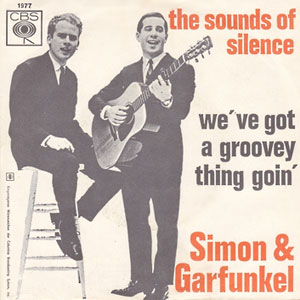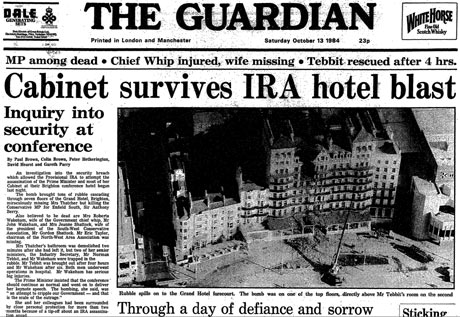
"Sounds of Silence" is the song that propelled the 1960s folk music duo Simon & Garfunkel to popularity. It was written in February 1964 by Paul Simon in the aftermath of the 1963 assassination of Johnm F. Kennedy. An initial version preferred by the band was remixed and sweetened, and has become known as "the quintessential folk rock release". In the U.S., it was the duo's second most popular hit after "Bridge Over Troubled Water".
The song features Simon on acoustic guitar and both singing. It was originally recorded as an acoustic piece for their first album Wednesday Morning 3.am. in 1964 but on the initiative of the record company's producer, Tom Wilson, it was later overdubbed with drums (Bobby Gregg), electric bass (Bob Bushnell) and electric guitar (Al Gorgoni), all without the knowledge or participation of Simon & Garfunkel and rereleased as a single in September 1965. The single reached number one on New Years Day 1966 and was included in the 1966 album Sounds of Silence.
"The Sound of Silence" was originally called "The Sounds of Silence" and is titled that way on the early albums in which it appeared and on the first single release; only on later compilations was it retitled "The Sound of Silence". Both the singular and the plural appear in the lyrics. In his book Lyrics 1964–2008 Simon has the title in the singular.

Paul Simon began working on the song some time after the Kennedy assassination. He had made progress on the music but had yet to get down the lyrics. On 19 February 1964, the lyrics coalesced, as Simon recalled: "The main thing about playing the guitar, though, was that I was able to sit by myself and play and dream. And I was always happy doing that. I used to go off in the bathroom, because the bathroom had tiles, so it was a slight echo chamber. I'd turn on the faucet so that water would run — I like that sound, it's very soothing to me — and I'd play. In the dark. 'Hello darkness, my old friend / I've come to talk with you again'."
Simon showed the new composition to Garfunkel the same day, and shortly afterward, the duo began to perform it at folk clubs in New York. In the liner notes of their debut album, Wednesday Morning 3 A.M., Garfunkel claims, "'The Sound of Silence' is a major work. We were looking for a song on a larger scale, but this is more than either of us expected."
The duo recorded it for the first time on March 10, and included the track on Wednesday Morning, 3 A.M., which was released that October. The album flopped upon its release, and the duo split up, with Simon going to England for much of 1965, hooking up with singer/songwriter Bruce Woodley of The Seekers. There he often performed the song solo in folk clubs, and recorded it for a second time on his solo LP in May 1965, The Paul Simon Songbook. In the meantime, Simon and Garfunkel's producer at Columbia Records in New York, Tom Wilson, had learned that the song had begun to receive airplay on radio stations in Boston, Massachussetts and around Gainsville and Cocoa Beach, Florida.

On June 15, 1965, immediately after the recording session of Bob Dylan's "Like a Rolling Stone", Wilson took the original acoustically instrumented track of Simon & Garfunkel's 1964 version, and overdubbed the recording with electric Guitar (played by Al Gorgoni and Vinnie Bell), electric bass (Joe Mack), and drums (Buddy Salzman), and released it as a single without consulting Simon or Garfunkel. The lack of consultation with Simon and Garfunkel on Wilson's re-mix was because, although still contracted to Columbia Records at the time, the musical duo at that time was no longer a "working entity". Roy Halee was the recording engineer, who in spirit with the success of The Byrds and their success formula in folk rock, introduced an echo chamber effect into the song. Al Gorgoni later would reflect that this echo effect worked well on the finished recording, but would dislike the electric guitar work they technically superimposed on the original acoustic piece.
For the B-Side, Wilson used an unreleased track he cut with the duo a few months earlier on which they had tried out a more "contemporary" sound. The record single "Sounds of Silence"/"We've Got a Groovey Thing Going" entered the U.S. pop charts in September 1965 and slowly began its ascent. In the first issue of crawdaddy! magazine, January 30, 1966, Paul Williams, in reviewing the later album, wrote that he liked this B-side song which he found pure "rock and roll", "catchy", with a "fascinating beat and melody" and great harmony.
Simon learned that it had entered the charts minutes before he went on stage to perform at a club in Copenhagen, and in the later fall of 1965 he returned to the U.S. By the end of 1965 and the first few weeks of 1966, the song reached number one on the U.S. charts. Simon and Garfunkel then reunited as a musical act, and included the song as the title track of their next album, Sounds of Silence, hastily recorded in December 1965 and released in January 1966 to capitalize on their success. The song propelled them to stardom and, together with two other top-five (in the U.S.) hits in the summer of 1966, "I am a Rock" and "Homeward Bound," ensured the duo's fame. In 1999, BMI named "The Sound of Silence" as the 18th-most performed song of the 20th century. In 2004, it was ranked No156 on Rolling Stone's list of the 500 Greatest Songs of all Time, one of the duo's three songs on the list.
On the duo's 1968 album Bookends, the track "Save the Life of My Child" features a distorted sample of Art Garfunkel's "Hello darkness my old friend, I've come to talk with you" line from the original recording of "The Sound of Silence").












